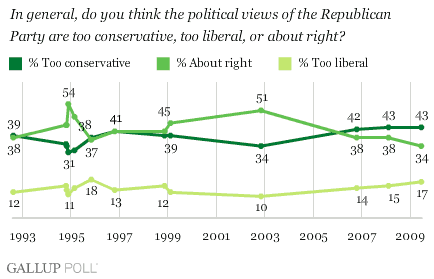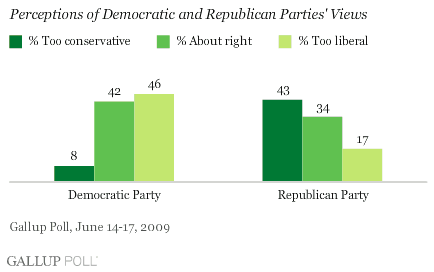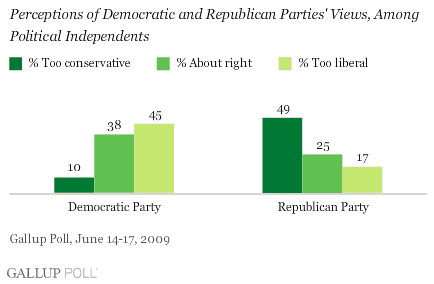PRINCETON, NJ -- A Gallup Poll finds a statistically significant increase since last year in the percentage of Americans who describe the Democratic Party's views as being "too liberal," from 39% to 46%. This is the largest percentage saying so since November 1994, after the party's losses in that year's midterm elections.

Notably, there has been no change over the past year in the percentage of Americans who say the Republican Party is "too conservative," though the 43% who say the party leans too far to the right matches the historical high mark set last year.

But the Democratic Party still compares favorably to the Republican Party from the standpoint that more Americans say the Democrats' ideology is "about right" (42%) than say this about the Republicans' ideology (34%).

Independents' Views of the Parties
Political independents' perceptions of the two major parties' ideological orientation are important since both parties need to appeal to the political center in order to win elections. (The vast majority of partisan identifiers predictably view their chosen party's views as being about right and the other party's as being too extreme.)
Currently, independents are more likely to view both parties as being too extreme in either direction than to believe they are about right. But more independents say the Democratic Party (38%) than the Republican Party (25%) is about right.
Independents are a little more likely to say the Republican Party is too conservative than to say the Democratic Party is too liberal, in a slight departure from the results among all Americans.

Implications
The Democratic Party continues to hold the upper hand over the Republican Party in the current U.S. political environment by a variety of measures, including party identification and party favorable ratings. However, compared to last year, Americans are significantly more likely to see the Democratic Party as too liberal, and as a result, they are somewhat more likely to view the party as being too far left than to perceive the Republican Party as too far right. That may expose a bit of a vulnerability for the Democratic Party, and if perceptions of the Democratic Party as being too liberal continue to grow, the GOP may be able to win back some of the support it has lost in recent years. But that may be possible only if the Republicans are at the same time able to convince the public that they are not too far to the political right.
Survey Methods
Results are based on telephone interviews with 1,011 national adults, aged 18 and older, conducted June 14-17, 2009. For results based on the total sample of national adults, one can say with 95% confidence that the maximum margin of sampling error is ±3 percentage points.
Interviews are conducted with respondents on land-line telephones (for respondents with a land-line telephone) and cellular phones (for respondents who are cell-phone only).
In addition to sampling error, question wording and practical difficulties in conducting surveys can introduce error or bias into the findings of public opinion polls.
